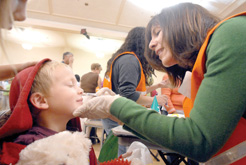
Local officials urge caution as cases increase around world
Local public health officials continued efforts to alert the
public about taking precautions to avoid the spread of swine flu
Wednesday as the number of confirmed cases in the United States
rose to 91, with one death reported in Texas, according to the
Centers for Disease Control and Prevention.
Local officials urge caution as cases increase around world
Local public health officials continued efforts to alert the public about taking precautions to avoid the spread of swine flu Wednesday as the number of confirmed cases in the United States rose to 91, with one death reported in Texas, according to the Centers for Disease Control and Prevention.
The World Health Organization upgraded the outbreak to phase 5 Wednesday afternoon. Phase 5 “is a strong signal that a pandemic is imminent and that the time to finalize the organization, communication and implementation of the planned mitigation is short,” according to the WHO site.
“Influenza pandemics must be taken seriously precisely because of their capacity to spread rapidly to every country in the world,” wrote Margaret Chan, the WHO director-general.
Of the U. S. cases, 14 were confirmed in California, though no cases had been reported in San Benito County at press time, according to local health officials.
The World Health Organization had confirmed cases in nine countries, including Austria, Canada, Germany, Israel, New Zealand, Spain and the United Kingdom, as well as Mexico, the country of origin for the global outbreak. The case count is at 148 worldwide, though many more cases are suspected in Mexico that have not been confirmed in a laboratory.
“We sent out health alerts to targeted populations to raise awareness that this is a new virus, but there is a treatment,” said Samela Perez, the public information officer for San Benito County’s Health and Human Services Agency Public Health Services, on Monday. “We also let them know what they can do, what are universal precautions.”
The CDC implemented its emergency response Wednesday in hopes of reducing transmission and severity of illness, as well as to provide more information to local health officials. CDC staff continue to release the antiviral drugs oseltamivir and zanamivir, which are effective in treating the illness.
Locally, health officials have targeted schools, labor camps and other agencies that can help get out the information about how to prevent the spread of illness. Some of the precautions include covering the nose and mouth when sneezing or coughing; washing hands frequently; avoiding close contact with sick people; and staying home if you have flu-like symptoms.
“People should stay in if they are sick,” Perez said. “Keep children home if they are ill – unless they have respiratory distress or a high fever, or something that warrants seeing a physician.”
The first U.S. cases of swine flu, influenza A (H1N1), a strain of the virus that is spread from pigs, were reported in late March and early April in Southern California and near San Antonio, Texas, according to a press release from the CDC. Cases had been confirmed in 10 states, at press time, with 51 cases in New York, 14 in California, 16 in Texas, and two or less in the other states.
According to the World Health Organization, the epicenter of the outbreak is in Mexico where more than 1,600 people reported a flu-like illness and more than 150 have died of it, according to reports from health agencies. Few of those cases have been tested by a laboratory to confirm that they are linked to the A/H1N1 virus.
With seasonal influenza, young and old populations, or those with chronic illness, are most susceptible to illness. But with new strains, they can attack healthy populations harder.
Public health officials have been keeping tabs on flu outbreaks for years in anticipation of the next pandemic that could occur when a new strain of flu to which humans do not have immunity starts to spread rapidly between people. The last flu pandemic was in 1976.
“We always thought it was going to come from Asia,” Perez said. “And we were anticipating a different strain of flu, but it has come up from Mexico.”
On April 27, the CDC issued an advisory to avoid all “nonessential travel to Mexico.”
In California, the cases have been confirmed in four counties – Sacramento, San Diego, Imperial and San Bernadino – but other probables cases were awaiting confirmation in six other counties.
“We’ve been preparing for this for two years,” Perez said, referring to the healthcare summits and the flu clinics the staff have conducted in the past. “The system is working. The plans that we’ve tested in the past, we are finding that all this collaboration is effective.
“We are starting the dialogue now. It’s a good thing that we start early on this stuff. Travel opportunities are much different than they used to be. People can get on a plane and be across the world in a short time.”
Those who show signs of the flu should contact a doctor, and those who would like more information on local efforts can call the San Benito Health Department at 637-5367.
Online resources
California Department of Public Health
www.cdph.ca.gov/Pages/default.aspx
Centers for Disease Control and Prevention
www.cdc.gov/swineflu/index.htm
World Health Organization
www.who.int/en/









